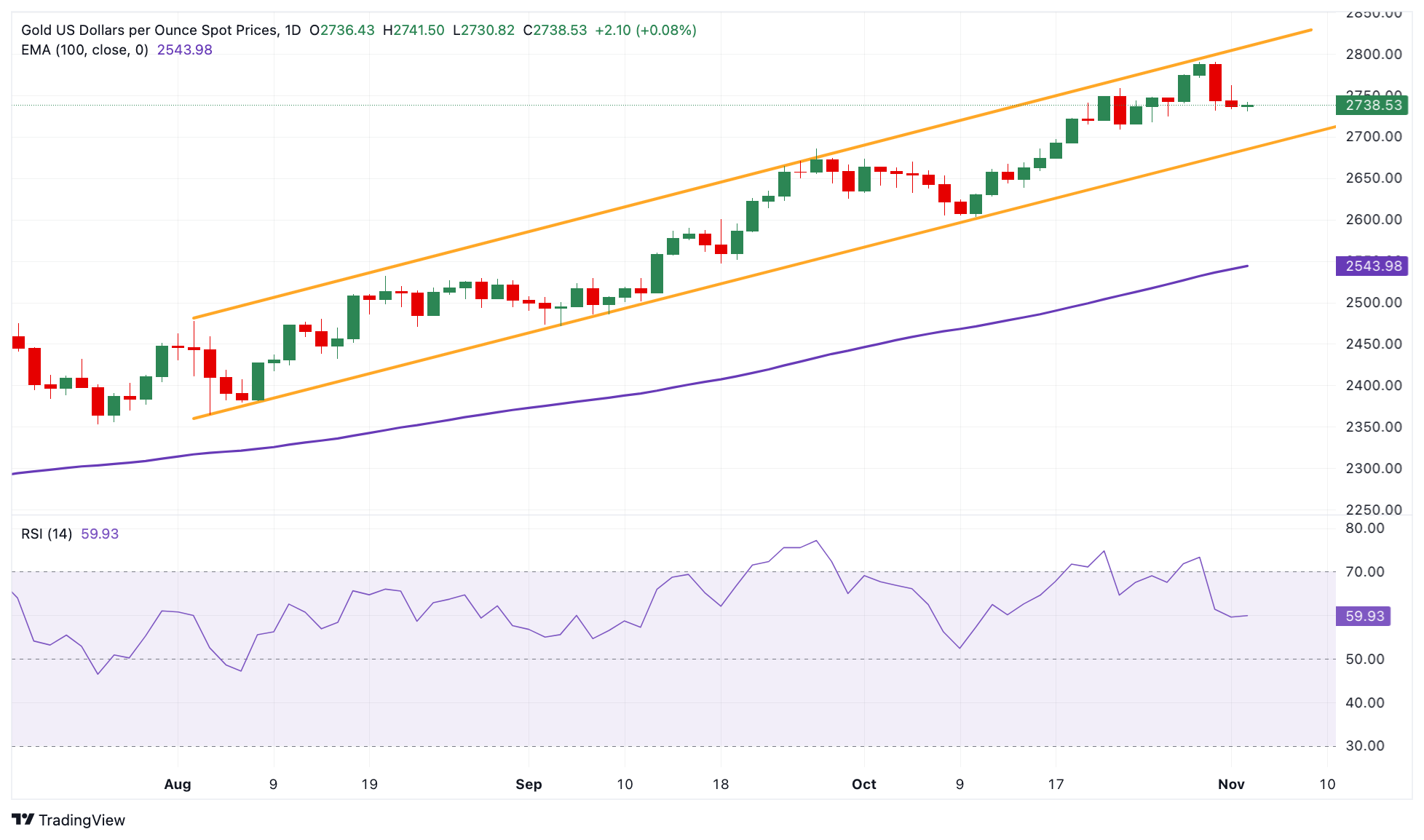Gold price stands firm amid US presidential election uncertainty

- Gold price drifts higher in Monday’s Asian session.
- Safe-haven demand amid US presidential election uncertainties, persistent Middle Eastern tensions, might lift the Gold price.
- Traders brace for the US election outcome on Tuesday ahead of the Fed rate decision.
The Gold price (XAU/USD) trades in positive territory on Monday. The US presidential election risks and the ongoing Middle East geopolitical tensions are likely to underpin the yellow metal, a traditional safe-haven asset, in the near term. Nonetheless, the renewed Greenback demand and higher US bond yields might cap the upside for Gold price as higher yields make non-yielding assets like bullion less attractive in comparison.
Investors will closely watch the looming US presidential election on Tuesday. The attention will shift to the US Federal Reserve (Fed) rate decision on Thursday. The uncertainty over the US election outcome is one reason markets assume the Fed will deliver a rate cut of the usual 25 basis points (bps) on Thursday, rather than repeat its outsized half-point easing.
Daily Digest Market Movers: Gold price remains strong ahead of US presidential election
- “ETFs should see further inflows due to the expected interest rate cuts, high fiscal deficits and the highly valued stock markets. However, investment demand in the fourth quarter could be heavily influenced by the outcome of the US elections. The central bank’s Gold purchases are likely to be strong again this year, but not at the levels seen in the previous two years. Jewelry demand is also expected to be lower than in the previous year, albeit somewhat higher than previously expected by the WGC,” noted Commerzbank analysts.
- PredictIt has placed a 51% chance of a Harris win on Tuesday, marking the vice president’s first lead over Trump (who leads Harris at a 49% chance) on the site since October 9.
- The US NFP increased by 12K in October, the smallest gain since December 2020. This figure followed the 223K rise (revised from 254K seen in September) and below the market consensus of 113K, by a wide margin.
- The Unemployment Rate was unchanged at 4.1% in October, matching the expectations.
- Financial markets have fully priced in a 25 basis points (bps) rate cut by the US Federal Reserve (Fed) at its November meeting on Thursday.
Technical Analysis: Gold price keeps the bullish vibe in the longer term
The Gold price edges higher on the day. The positive picture of the precious metal prevails as the price holds above the key 100-day Exponential Moving Average (EMA) on the daily chart. Furthermore, the 14-day Relative Strength Index (RSI) stands above the 50-midline near 60.20, suggesting the support level is likely to hold rather than break.
More green candlesticks above the all-time high and psychological mark in the $2,790-$2,800 zone could bump XAU/USD to $2,850.
On the other hand, consistent trades below $2,715, the low of October 24 might drag the yellow metal to $2,624, the low of September 30, followed by the $2,600 round mark.
Gold FAQs
Gold has played a key role in human’s history as it has been widely used as a store of value and medium of exchange. Currently, apart from its shine and usage for jewelry, the precious metal is widely seen as a safe-haven asset, meaning that it is considered a good investment during turbulent times. Gold is also widely seen as a hedge against inflation and against depreciating currencies as it doesn’t rely on any specific issuer or government.
Central banks are the biggest Gold holders. In their aim to support their currencies in turbulent times, central banks tend to diversify their reserves and buy Gold to improve the perceived strength of the economy and the currency. High Gold reserves can be a source of trust for a country’s solvency. Central banks added 1,136 tonnes of Gold worth around $70 billion to their reserves in 2022, according to data from the World Gold Council. This is the highest yearly purchase since records began. Central banks from emerging economies such as China, India and Turkey are quickly increasing their Gold reserves.
Gold has an inverse correlation with the US Dollar and US Treasuries, which are both major reserve and safe-haven assets. When the Dollar depreciates, Gold tends to rise, enabling investors and central banks to diversify their assets in turbulent times. Gold is also inversely correlated with risk assets. A rally in the stock market tends to weaken Gold price, while sell-offs in riskier markets tend to favor the precious metal.
The price can move due to a wide range of factors. Geopolitical instability or fears of a deep recession can quickly make Gold price escalate due to its safe-haven status. As a yield-less asset, Gold tends to rise with lower interest rates, while higher cost of money usually weighs down on the yellow metal. Still, most moves depend on how the US Dollar (USD) behaves as the asset is priced in dollars (XAU/USD). A strong Dollar tends to keep the price of Gold controlled, whereas a weaker Dollar is likely to push Gold prices up.
